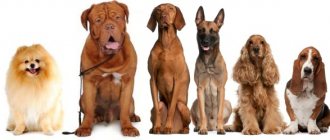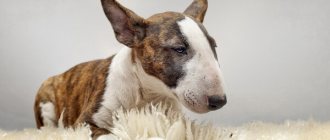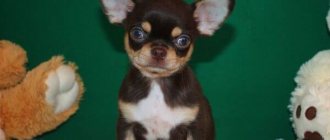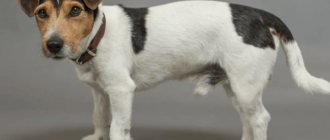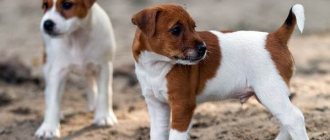Many people believe that the bull terrier breed is a symbol of uncontrollable aggression, strength and power. However, even according to professional dog handlers, these dogs are not capable of working as security guards or bodyguards, since they will not be able to show increased aggressiveness towards humans.
When raising bull terrier puppies, breeders always check the young generation for aggressiveness. If one of them behaves inappropriately or is incapable of obedience, then these representatives are rejected. The black bull terrier is of particular interest to dog breeders. It’s worth getting to know this four-legged animal better.
A little history
Many people believe, due to the slanting shape of the eyes, that dogs of this breed first appeared in Asia. But in fact, these dogs came to us from England. The breed was created by James Hinks, who in the 50s of the 19th century decided to create a completely new, perfect dog.
Initially, he dreamed of a snow-white dog, which would completely lack all the disadvantages of the English bulldog and terrier. The plan was realized in 1862. The Bull Terrier was created by crossing an English Bulldog, a White English Terrier and a Dalmatian. According to the creator's opinion, the ideal bull terrier appeared as a result of this experiment.
However, it is worth noting that according to other sources, the English bull terrier appeared about 200 years ago. There is a lot of evidence for this. For example, in 1820, on the canvases of some English artists, images of animals were found that very much resembled these unusual dogs. The breed was officially introduced in 1862 in Birmingham.
If we talk about black bull terriers and dogs of other colors, they began to be bred only in the middle of the 20th century. Today you can find four-legged pets of the most unusual colors.
Life expectancy and diseases
The average life expectancy of a black bull terrier is 12-13 years.
These dogs may be susceptible to the following diseases:
- Kidney diseases.
- Congenital dislocation of the elbow joint.
- Congenital deafness.
- Eversion or inversion of the eyelid.
- Demodecosis.
- Lethal acrodermatitis.
- Mastocytoma
- Mitral dysplasia.
- Osteochonditis of the hock joint.
- Osteochondrodysplasia.
- Prolapse of the third eyelid.
- Klein-Waardenburg syndrome
- Aortic stenosis.
- Solar dermatitis.
- Shortening of the palpebral fissure.
- Folliculitis or nasal furunculosis.
Why is a dog considered evil?
However, why are people sure that representatives of this breed are incredibly aggressive and strong? It is worth noting that although in the photo the black bull terrier looks quite serious and even threatening, it does not pose any danger to humans.
Nevertheless, we should not forget that the blood of a real fighting dog flows in him. Like many other representatives of four-legged animals, representatives of this breed enjoy hunting cats. Perhaps this is what served as the basis for the first legends about the aggressiveness and ruthlessness of these animals.
On the other hand, it should be noted that for many years the bull terrier was bred exclusively as a fighting dog. It was never used for protection or service, exclusively for competitions. That is why this animal has such a compact body and large muscle mass.
A white or black bull terrier does have a steel jaw and reduced sensitivity to pain. All these qualities make the animal a real fighter. That is why for a very long time it was used exclusively for the amusement of people who gladly bet on the bloody fights of four-legged animals. Perhaps, over many years of such entertainment, a clear opinion has formed that this animal is extremely aggressive and furious.
Indeed, dogs of this breed show very serious aggression towards their rivals. However, if we talk about how animals treat humans, then in this case a black and white bull terrier or a pet of a different color shows exceptional friendliness and obedience.
Character and habits of bull terriers
Despite their reputation, Bull Terriers are good-natured, cheerful dogs. A study by the American Canine Association found that only 10% of the breed retained the fighting qualities of their ancestors and can pose a danger to humans. The rest, with proper socialization and strict upbringing, become lovely pets. Problems arise due to improper behavior of owners.
A dog should not be allowed to bite people or other animals; it is even more prohibited to bait bulls or develop fighting qualities in them. An improperly trained dog can even bite its owner. And with the strength of his teeth, this can lead to serious injury. These dogs also have a developed instinct of pursuit. Therefore, they can attack other animals. Bull Terriers are highly active even in adulthood. The dog is ready to play and run around the clock. Pets love to accompany their owner when running and cycling. If you don't give your dog exercise, he will throw out energy at home and can cause damage to the environment.
A dog's behavior greatly depends on its upbringing. Each breed has temperamental characteristics that need to be taken into account. Bull Terriers are characterized by hyperactivity, autonomy, and independence. They are willful, touchy and vulnerable, and may be jealous or suffer from depression. But besides the negative qualities, the character of bull terriers has many positive traits.
- Representatives of the breed have a stable psyche. They are not shy, not aggressive. If the beloved owner is nearby, the dog will be calm in any environment.
- These dogs have a sense of humor. They can make the owner laugh and cheer him up. And the structure of the muzzle is such that the dog can smile.
- The Bull Terrier is a good-natured, friendly pet, not at all angry. He loves people and greets guests joyfully.
- This is a devoted dog, he loves his owner very much. Accompanies him everywhere, misses him. This is the perfect companion.
These dogs love children and enjoy playing with them. The main thing is that adults are nearby, as the bull can accidentally push the child, because he is quite clumsy. He also does not tolerate being teased or hurt. The child must be old enough to understand how to behave. After all, even a slight bite from this dog can be dangerous. The video shows that these dogs are cute, good-natured and cheerful:
Why is a bull terrier dangerous?
The negative reputation of bull terriers appeared due to unscrupulous breeders. When these dogs became popular, kennels started breeding them without caring about their temperament. Breeders did not pay attention to the selection of individuals with a stable psyche and lack of aggression. And owners often cultivated fighting instincts. From their ancestors, representatives of the breed inherited qualities that can make them dangerous.
- A tenacious grip of powerful jaws that is difficult to release. This dog can hold a bite for up to 3 hours. You can force him to release his grip by holding ammonia to his nose.
- The Bull Terrier's build is strong and muscular. He is very dexterous, agile, moves easily and actively. Moreover, it can cause pain even when showing tender feelings to the owner, since it does not have delicacy.
- This dog is hardy and stubborn, capable of making independent decisions. Can rush at a person whom it considers a threat. And if the dog starts something, he won’t back down. For this reason, you should not train bull terriers or give them the “front” command.
- The desire to win and the willingness to fight to the end. The Bull Terrier will fight bravely against an opponent stronger than him. These dogs are insensitive to pain.
Many people confuse the Bull Terrier with similar breeds. These are the American Staffordshire Terrier, the English Staffordshire Bull Terrier, and the American Pitbull. It is the latter breed that is dangerous and prohibited for breeding in many countries. Pit bulls are aggressive, fearless, and can attack at any time. And bull terriers rarely make it into the rankings of the most aggressive dog breeds.
Appearance
If we talk about what a white (this color is considered the original) or black bull terrier looks like, then, of course, the first thing that catches your eye is its strong physique and pronounced muscles.
In terms of size, the males of these dogs are much larger than the “girls”. The dog weighs about 20-25 kilograms. His height rarely exceeds 45 cm.
The Bull Terrier has a slightly elongated oval head. From the back of the head to the nose, you can see a smooth arc. In the area between the ears the skull becomes almost flat.
Separately, it is worth describing the animal’s face. If you look at a photo of a black and white bull terrier, you will clearly see massive jaws, the lower part of which is set a little deeper.
The lips fit very tightly to the jaw apparatus. The eyes are slightly slanted and black. When animals are at rest, their visual organs appear significantly smaller. However, as soon as the dog is excited, his pupils become greatly enlarged. Because of this, his eyes actually seem to change.
The Bull Terrier has very thin small triangular ears that are set quite close. As a rule, they stick out vertically. Most muscle mass is observed in the neck, shoulders and back.
Black and white bull terriers have a rather short tail, which tapers slightly towards the end. The dog's hind limbs are distinguished by very powerful bones, so when running the dog is able to develop quite a high speed.
The animal's fur is quite short and smooth. It is evenly distributed throughout the body.
Dimensions, weight and other distinctive features
Size
From 53 to 56 cm at the withers.
There is also a mini variety.
Weight
Approximately 23-32 kg.
General form
An energetic and active medium-sized dog with a strong and muscular build.
Head
The shape resembles an oval, pointed and slightly narrowed on one side. The forehead is somewhat flattened, the transition to the muzzle is weakly expressed, arched.
Ears
Placed strictly vertically, small and rather thin.
Eyes
Deep-set, slightly slanting and narrow, shaped like an elongated triangle. The most preferred eye color is dark brown.
Neck
Powerful and strong.
Back
Quite short and strong.
Rib cage
Deep, voluminous and muscular.
Stomach
Moderately selected.
Limbs
Not particularly long, smooth and strong. The hindquarters are strong, with well-developed muscles on the thighs and correct angulations.
Tail
Thick at the base but tapering towards the end, short and low set.
Wool
Quite short, shiny and harsh.
Character traits
Of course, the bull terrier is distinguished by courage, tenacity and fearlessness. It is thanks to such qualities that it is necessary to raise a small puppy in a timely manner. He needs training and the understanding that a person is his master. If the owner of the animal does not follow standard training recommendations, then this dog will be impossible to control and it will begin to demonstrate its temper with pleasure.
If you raise black bull terrier puppies and turn to specialists, the animal will grow up absolutely calm and friendly. These dogs are loyal friends of people.
If we talk about the main character traits of this breed, the dogs are distinguished by endurance, curiosity, energy and stubbornness. Meanwhile, the bull terrier is very touchy, so you need to understand that if you show aggression towards this puppy or punish him too much, then there is a risk that he will remember this for many years.
Despite the fact that in a critical situation a bull terrier can come to the rescue, you need to understand that this breed of dog is not a guard dog. These animals are not capable of attacking an adult or child.
You need to be prepared for the fact that the dog’s behavior will change dramatically on an area with other animals. The Bull Terrier is very aggressive towards other four-legged animals, so you need to monitor your pet very carefully.
Basic rules of care
The Black Bull Terrier needs to be brushed every few days, but dogs of this breed are bathed rarely and only as needed.
A dog's ears and eyes need regular examinations, which are best done daily. If they become dirty, they need to be cleaned using special products in the form of drops or lotions, which can be purchased at a veterinary pharmacy and then used according to the instructions.
IMPORTANT!
The dog cleans its teeth by eating solid food, but if plaque forms that is difficult to remove, they need to be cleaned with a toothbrush coated with toothpaste for dogs.
The claws of a black bull terrier, if they do not wear down during walks, need to be trimmed using a nail clipper. Considering that in dark dogs the living part of the claw is not visible, they must be shortened very carefully, cutting off no more than 1-2 mm at a time until a grayish dot is visible on the cut.
Good to know
If we consider the characteristics of this animal, it becomes obvious that such a dog is not suitable for every owner. If a person is not able to spend a lot of time on training and training a dog, then it is better to refuse such a purchase. Otherwise, even a black or white mini bull terrier can grow uncontrollable and bring a lot of trouble to its owner.
The dog is distinguished by enormous physical strength and persistent character, therefore the person himself must be strong and powerful enough to be able to suppress the will of the animal and show who is boss in the house. If the future pet owner is famous for his gentle disposition, then he should pay attention to other dogs.
Description of the breed
The Bull Terrier breed is distinguished by its enormous endurance, as well as excessive activity. She is in excellent health and has a courageous character.
With appropriate training, the dog is obedient and friendly, even despite its external appearance.
An undeniable quality is a huge affection for the owner. It is impossible to imagine a description of this breed without mentioning the dog’s conflict with other animals, so it is better to get only one dog, because innate aggression will cause constant rivalry.
- External characteristics. The dog is strong and has pronounced muscles. Males are larger compared to females. Body weight reaches 15-32 kg.
- Muzzle. The jaws are large.
- The head is oval, elongated. The skull is almost flat.
- The tail is quite short.
- The coat is smooth and short, covering the entire dog's body.
- The color is snow-white and colored. In the first case, the snow-white coat may be covered with spots.
Bull Terrier color
This dog breed was originally bred exclusively in white. However, after some time, when the popularity of the bull terrier became simply enormous, the breeders decided to diversify the market a little. Today, both classic white bull terriers and black ones are very popular.
At the same time, even in the most elite kennels in Moscow, bull terriers are found in brindle, red, red or tricolor colors. Today, such dogs are also considered purebred. However, if we are talking about blue or sand color, as well as wool with patches, then in this case the breed is a cross.
Bull Terriers may have distinct markings.
Tendency to diseases
Bull Terriers have very good immunity and excellent health. But there are some points that are hereditary:
- Deafness, partial hearing impairment. In white bull terriers it occurs in 20% of cases, in other colors in 1.3%.
- Polycystic kidney disease.
- Astigmatism.
- Epilepsy.
- Mitral heart valve defect.
- Failure of development of any organ.
- Skin damage.
- Allergy.
- Decreased thyroid function.
- Aortic stenosis.
- Malignant tumor of the skin.
With timely vaccination, many diseases can always be avoided. This procedure is strictly performed in a veterinary clinic. If you entrust your dog to an experienced specialist, your pet will be healthy, vigorous and have good immunity. You can also always get advice from a veterinarian on proper balanced feeding of your dog, and find out hereditary diseases of dogs of this breed. In general, the average life expectancy of dogs of this breed varies from 10-15 years.
The average lifespan of bull terriers varies from 10-15 years
What you need to know! Have your dog examined at a veterinary clinic annually to prevent disease and prompt treatment.
How to choose a puppy
In order to purchase such a dog, you must contact exclusively professional breeders. The seller must provide a complete list of documents for the animal. The puppy should be from 2 to 2.5 months old, but no more. It is also worth paying attention to its appearance.
A baby bull terrier, black or any other color, must be healthy. All information about vaccinations and other procedures is indicated in his passport. He must undergo anthelmintic prophylaxis.
Keeping a Bull Terrier
Before buying a puppy, it is important to understand that he needs his own corner, which will belong only to him. Accordingly, it is recommended to find a place where the pet will be comfortable. It is better to install the lounger in a place with dim light. The animal should not be in a draft.
He definitely needs to buy toys that are strictly prohibited from touching other family members. Your puppy should always have clean drinking water.
These puppies can be kept both in a small apartment and in a large country house. It is not recommended to keep a dog outside, as bull terriers do not tolerate cold, dampness and temperature changes very well. In summer, the animal can overheat in the sun, so you need to make sure that the dog is always under a canopy.
It is worth noting that this animal requires a rather serious approach, and therefore a person who has not previously encountered pets in the form of dogs should exercise caution.
Content. Care. Disease Prevention
Before you get a bull terrier, you need to prepare because keeping such a dog requires a lot of effort and time.
- First you need to prepare a place for the dog where it will be comfortable; a place where the whole family gathers is perfect. Choose medium-compact litter.
- Buy 2 feeding bowls - for food and fresh water.
- Purchase the necessary tools and hygiene products - brushes, detergents, scissors.
- The dog must have a collar with a leash and a muzzle.
- Keep a veterinary first aid kit and constantly monitor the availability of medications.
- Allow plenty of time for walking and training.
- Provide your dog with toys.
- During cold periods, the Bull Terrier needs warmth, so for walks, purchase special clothing for dogs.
Necessary items for providing first aid to a dog
Caring for a Bull Terrier is not difficult; it will support your pet’s immunity and excellent appearance. Pay attention to your dog's coat, nails, ears and physical condition.
Bull Terriers have a smooth and short coat that does not shed often. It is necessary to comb the dog several times, in the autumn and spring this is done often to eliminate the presence of hair throughout the house. Often bathing can be used only in isolated cases; after a walk in a contaminated area, in general, you can get by with wiping with a wet towel. In the first months after birth, you should not bathe the puppy at all, so as not to destroy the antimicrobial barrier. And the most important thing. To ensure your dog has a healthy and well-groomed coat, provide your dog with a balanced diet.
You also need to pay a little attention to the condition of the claws. If you live in an urban area, then the claws themselves grind down on hard surfaces while walking. If you are in a suburban area, you should trim the nails yourself so that your pet’s nails do not break off and the blood vessel is not injured, which can cause inflammation.
Clean your ears daily with a cotton pad. Without skill, it is better not to use a cotton swab. To avoid harming the pet. Eyes also need to be wiped with napkins.
Bull Terriers require a lot of physical activity
What you need to know! Bull Terriers are very active dogs that require a lot of physical activity. If you do not pay attention to this, your pet will develop many diseases. To prolong the healthy life of a dog, it is necessary to complete a professional training course on time and actively engage with the dog, then your pet will be active, healthy and sociable.
The prevention of many diseases will be the dog's active lifestyle, its balanced diet, and daily hygiene procedures. The first mating should not be earlier than 2 years. If mating is carried out earlier, it can harm the health of the pet and negatively affect the bearing of offspring. If any signs of disease appear, you should immediately consult a veterinarian.
The Bull Terrier is a short-haired dog and in winter they need special clothing to protect them from the cold.
Training and education
It is worth noting that these dogs are very difficult to train. Education is only possible if it is carried out by experienced trainers. Bull Terriers are very restless and capricious; they prefer to do only what they like.
Therefore, you need to be strict from the very childhood of the puppy. It is important to teach him to calmly react to the fact that a person takes away his toy or bowl. When communicating with an animal, you should not show aggression or obvious dissatisfaction. You need to behave very calmly. Don't feign anger or try to be too loud. The dog understands very well when he is being deceived.
Don't put too much pressure on the dog. You can try to train a bull terrier at home, give him treats when performing certain actions, but if the animal refuses to do this, there is no need to press him.
Caring for Bull Terrier dogs
Bull Terriers are dogs that do not require much grooming. You need to bathe 2-3 times a year, but wash your paws after a walk. Short wool, if it becomes dirty, can be wiped with a damp cloth. There is also no need to comb it often; this is done 1-2 times a week using a special mitten or a stiff brush. During molting - daily. You should regularly examine your pet's eyes and ears. If necessary, wipe them with a cotton swab dipped in veterinary lotion. It is also recommended to brush your teeth several times a week with a special paste to avoid the formation of tartar. If the claws do not grind down on their own, they are trimmed every month with a nail clipper.
Walk
The Bull Terrier will become the best pet only if you provide it with long walks and physical activity. He needs jogging, outdoor games, the dog loves to run after a ball or Frisbee, and accompany the owner when riding a bicycle. During walks, the bull terrier must be on a leash. And in crowded places or on dog parks, it is advisable to put a muzzle on him. Even a well-mannered dog can lunge at a person or another dog if it feels a threat to itself or its owner. And since he is strong and agile, it is not always possible to hold him. Photos of bull terriers on a walk:
On a walk
We're walking
Diet
You can feed your bull terrier natural food or dry food. The diet must be selected carefully, only fresh foods should be given; these dogs often have allergies and indigestion. The main place in the diet should be lean meat, preferably raw, which is doused with boiling water. It is also important to give offal, cereals, vegetables, vegetable oil, sea fish, eggs, and dairy products. Veterinarians recommend adhering to the following rules:
- always feed at the same time;
- do not give food from your table or a lot of treats;
- dogs fed natural food need to add vitamins to their food;
- Do not give chocolate, smoked meats, fatty and spicy foods, baked goods, sausage, nuts;
- if the pet refuses to eat, you need to change the diet; bull terriers are capricious in their choice of food;
- Change your diet gradually; you cannot combine natural food and dry food.
If your dog is fed industrial food, you should give preference to the premium and super-premium class. Suitable foods are Royal Canin, Acana, Brit Care, Probalance, intended for medium breed dogs.
Health
If you create normal conditions for your pet, he will live 13-14 years without illness. These are healthy dogs with almost no congenital pathologies. Sometimes found:
- joint dysplasia, especially affecting the elbows and knees;
- entropion of the eyelids, inflammatory eye diseases;
- atopic dermatitis;
- congenital deafness;
- epilepsy.
With the wrong choice of diet or unsuitable living conditions, bull terriers can suffer from allergies, obesity, and indigestion. These dogs are susceptible to colds, as they do not tolerate cold well, and individuals with white fur may develop sunburn. It is also important to carry out timely vaccinations and treat your pet against parasites.
Nutritional Features
If we are talking about ready-made food, it is recommended to feed only premium food or natural food. However, under no circumstances should these two types of food be mixed. Dry food is selected based on the characteristics of a particular animal, that is, its weight and age.
During the period of its active growth, you need to provide the puppy with a large amount of nutrients, minerals, and vitamins. Nutrition should be balanced. Under no circumstances should you use expired canned food or other products.
Feeding
Puppies grow quite quickly, gaining height by nine months. After this age, the animal's development consists of muscle development. What should a bull terrier's diet be?
Remember that this breed quickly gains excess body weight. Eventually:
- the breed requires one meal per day;
- Be sure to teach your pet to seek food only when hungry;
- do not add more food than you should;
- do not offer gourmet foods so as not to spoil your pet;
- the main part of the diet is natural meat products;
- the second part of the meal is foods with minerals and calcium.
What to feed
First of all, this animal can be given poultry and animal meat. Despite the fact that raw food is recommended for these dogs, it is worth dousing the meat with boiling water first to avoid infection with helminths.
Additionally, you can give chicken gizzards, necks, hearts and other offal. If we talk about fish, then only boiled seafood products are allowed. You can sometimes pamper your puppy with raw eggs, vegetable oil, dairy products and cereals.
What not to give to puppies
The only type of meat that is strictly forbidden to be given to representatives of this breed is pork. You should also refrain from using smoked meats, sweets, baked goods, seasonings, river fish and spicy foods in the animal’s diet.
You need to immediately accustom the puppy to eating. It is best to feed him immediately after a walk. The serving size depends on the age of the animal. Typically, the smaller the puppy, the more he needs because he burns a huge amount of energy.
The food bowl should be filled within 10-15 minutes. If your pet refuses to eat, then you need to put the plate in the refrigerator until the next feeding. If the dog knows that he always has food, he may begin to eat uncontrollably and will not comply with the regime.
